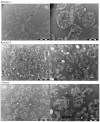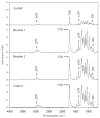Production of Poly(3-hydroxybutyrate- co-3-hydroxyvalerate) (PHBV) by Haloferax mediterranei Using Candy Industry Waste as Raw Materials
- PMID: 39329612
- PMCID: PMC11429114
- DOI: 10.3390/bioengineering11090870
Production of Poly(3-hydroxybutyrate- co-3-hydroxyvalerate) (PHBV) by Haloferax mediterranei Using Candy Industry Waste as Raw Materials
Abstract
The haloarchaeon Haloferax mediterranei synthesizes poly(3-hydroxybutyrate-co-3-hydroxyvalerate) (PHBV) under unfavorable nutritional conditions without the addition of any precursor to the culture, which is an advantage compared to other microbial counterparts able to synthesize polyhydroxyalkanoates (PHA). PHBV is a biodegradable polymer showing physiochemical properties of biotechnological and biomedical interest and can be used as an alternative to plastics made from chemical synthesis (which are not environmentally friendly). The versatile metabolism of H. mediterranei makes the use of waste as a carbon source for cellular growth and PHA synthesis possible. In this work, cellular growth and the production and characterization of PHBV using two different types of confectionery waste were analyzed and compared with cellular growth and PHBV synthesis in a standard culture media with glucose of analytical grade as a carbon source. The PHBV granules produced were analyzed by TEM and the biopolymer was isolated and characterized by GC-MS, FTIR NMR, and DSC. The results reveal that H. mediterranei can use these two residues (R1 and R2) for pure PHBV production, achieving 0.256 and 0.983 g PHBV/L, respectively, which are among the highest yields so far described using for the first-time waste from the candy industry. Thus, a circular economy-based process has been designed to optimize the upscaling of PHBV production by using haloarchaea as cell factories and valorizing confectionery waste.
Keywords: bioplastics; candy waste; haloarchaea; poly(3-hydroxybutyrate) (PHB); poly(3-hydroxybutyrate-co-3-hydroxyvalerate) (PHBV); poly(3-hydroxyvalerate) (PHV); polyhydroxyalkanoates (PHA).
Conflict of interest statement
The authors declare no conflicts of interest.
Figures



Similar articles
-
Advanced Strategies for Poly(3-hydroxybutyrate-co-3-hydroxyvalerate) Production: PHA Synthase Homologous Overexpression in the Extremophile Haloferax mediterranei.Mar Drugs. 2025 Apr 11;23(4):166. doi: 10.3390/md23040166. Mar Drugs. 2025. PMID: 40278287 Free PMC article.
-
Effect of levulinic acid on production of polyhydroxyalkanoates from food waste by Haloferax mediterranei.Environ Res. 2022 Nov;214(Pt 3):114001. doi: 10.1016/j.envres.2022.114001. Epub 2022 Aug 5. Environ Res. 2022. PMID: 35934144
-
Evaluating haloarchaeal culture media for ultrahigh-molecular-weight polyhydroxyalkanoate biosynthesis by Haloferax mediterranei.Appl Microbiol Biotechnol. 2021 Sep;105(18):6679-6689. doi: 10.1007/s00253-021-11508-3. Epub 2021 Aug 30. Appl Microbiol Biotechnol. 2021. PMID: 34459953
-
Bioplastic Production from Agri-Food Waste through the Use of Haloferax mediterranei: A Comprehensive Initial Overview.Microorganisms. 2024 May 21;12(6):1038. doi: 10.3390/microorganisms12061038. Microorganisms. 2024. PMID: 38930420 Free PMC article. Review.
-
Biomedical Applications of the Biopolymer Poly(3-hydroxybutyrate-co-3-hydroxyvalerate) (PHBV): Drug Encapsulation and Scaffold Fabrication.Int J Mol Sci. 2023 Jul 19;24(14):11674. doi: 10.3390/ijms241411674. Int J Mol Sci. 2023. PMID: 37511432 Free PMC article. Review.
Cited by
-
Advanced Strategies for Poly(3-hydroxybutyrate-co-3-hydroxyvalerate) Production: PHA Synthase Homologous Overexpression in the Extremophile Haloferax mediterranei.Mar Drugs. 2025 Apr 11;23(4):166. doi: 10.3390/md23040166. Mar Drugs. 2025. PMID: 40278287 Free PMC article.
-
Bioconversion of bread waste into high-quality proteins and biopolymers by fermentation of archaea Haloferax mediterranei.Front Microbiol. 2024 Dec 24;15:1491333. doi: 10.3389/fmicb.2024.1491333. eCollection 2024. Front Microbiol. 2024. PMID: 39777146 Free PMC article.
References
-
- Gianico A., Gallipoli A., Gazzola G., Pastore C., Tonanzi B., Braguglia C.M. A novel cascade biorefinery approach to transform food waste into valuable chemicals and biogas through thermal pretreatment integration. Bioresour. Technol. 2021;338:125517. doi: 10.1016/j.biortech.2021.125517. - DOI - PubMed
-
- Kaza S., Yao L., Bhada-Tata P., Van Woerden F. What a Waste 2.0: A Global Snapshot of Solid Waste Management to 2050. World Bank Publications; Whasington, DC, USA: 2018.
Grants and funding
LinkOut - more resources
Full Text Sources
Molecular Biology Databases
Miscellaneous

